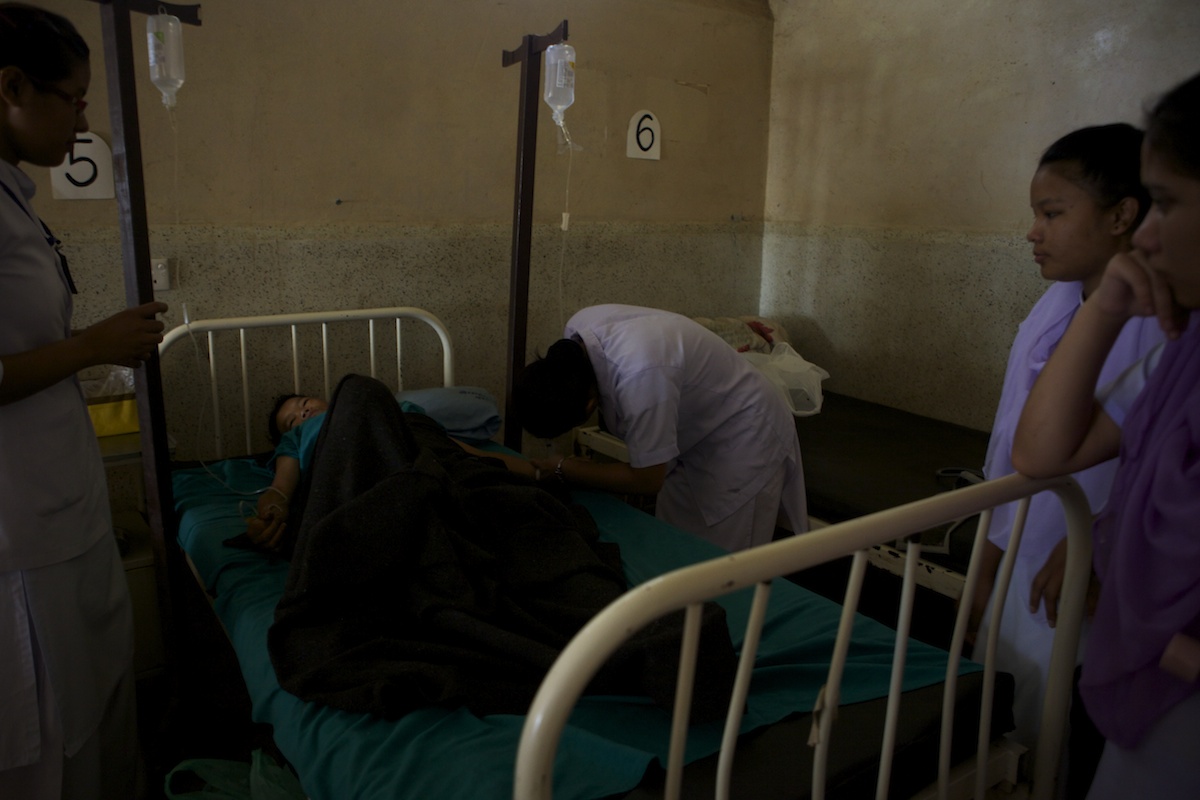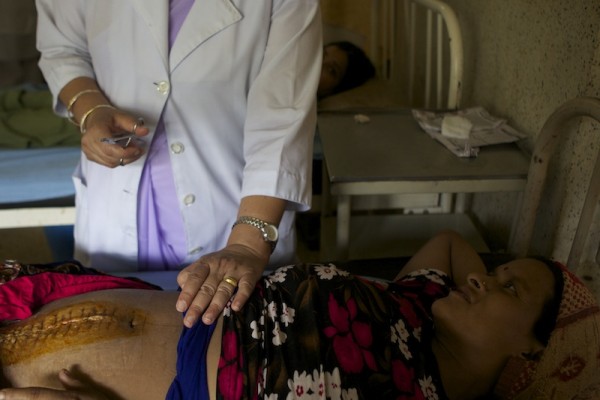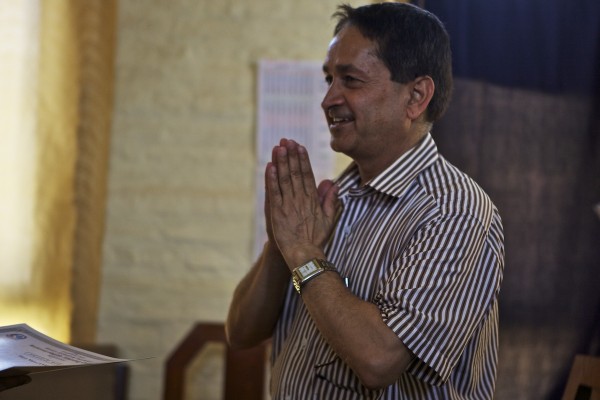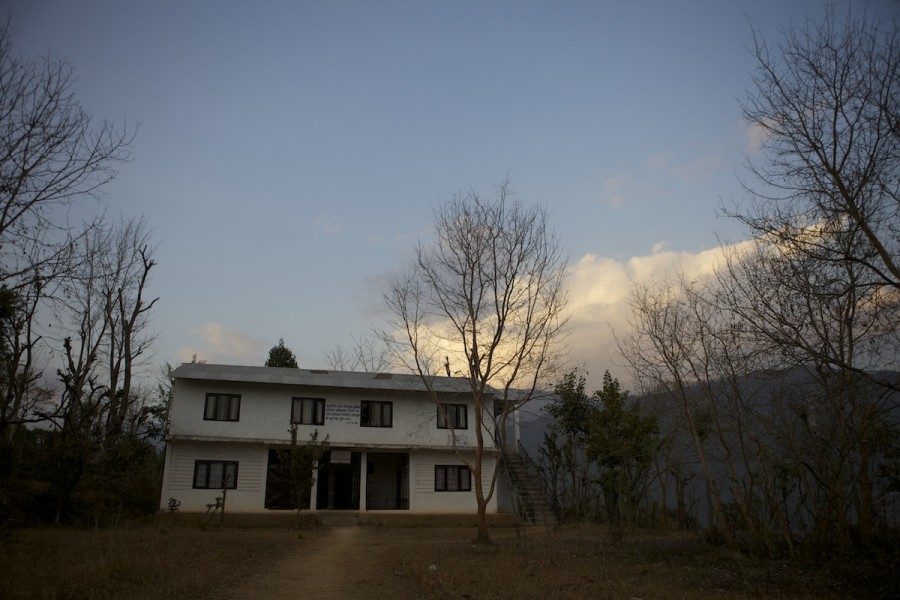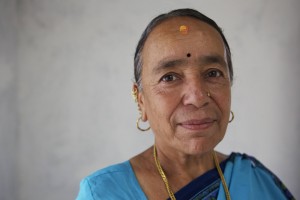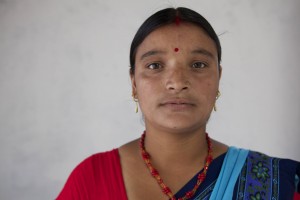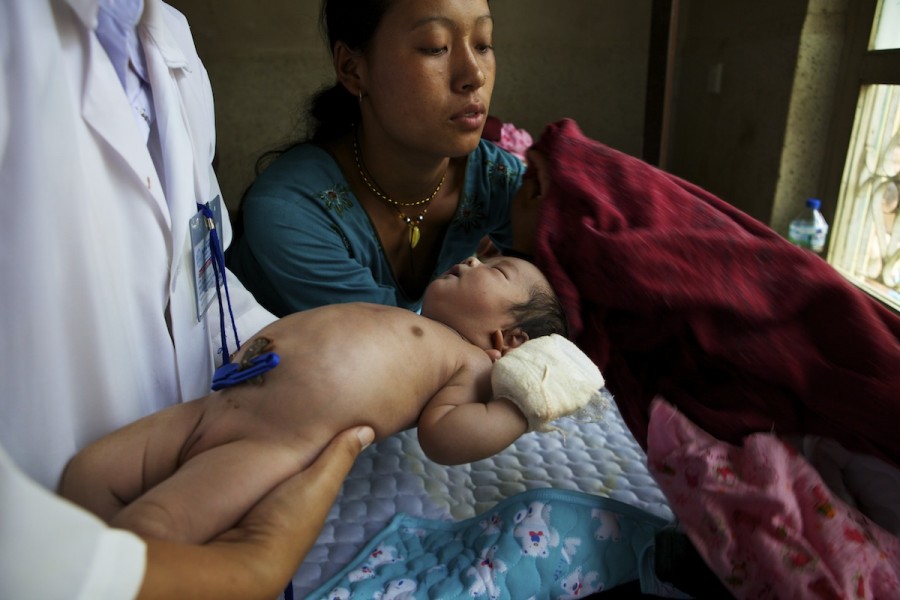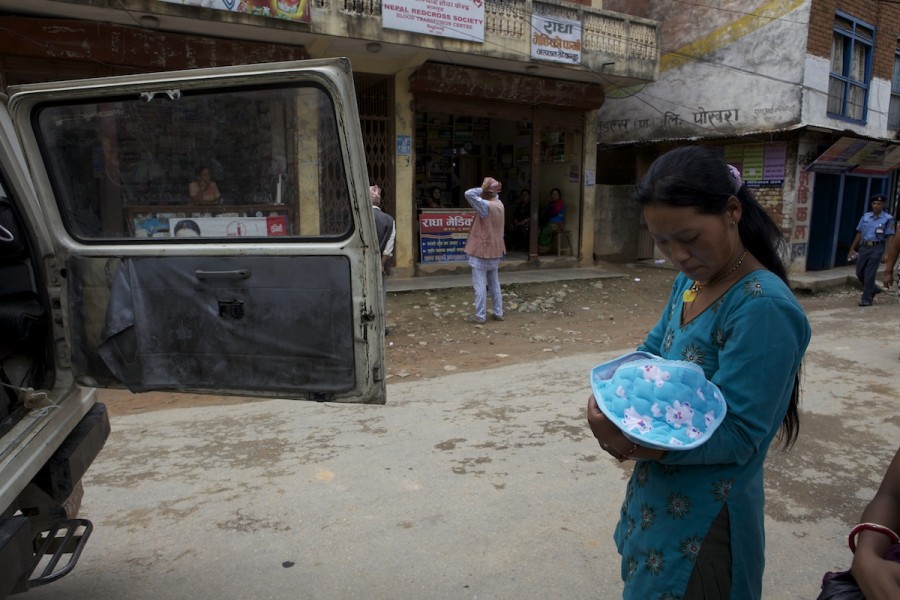Life and Death in the Kali Gandaki Valley
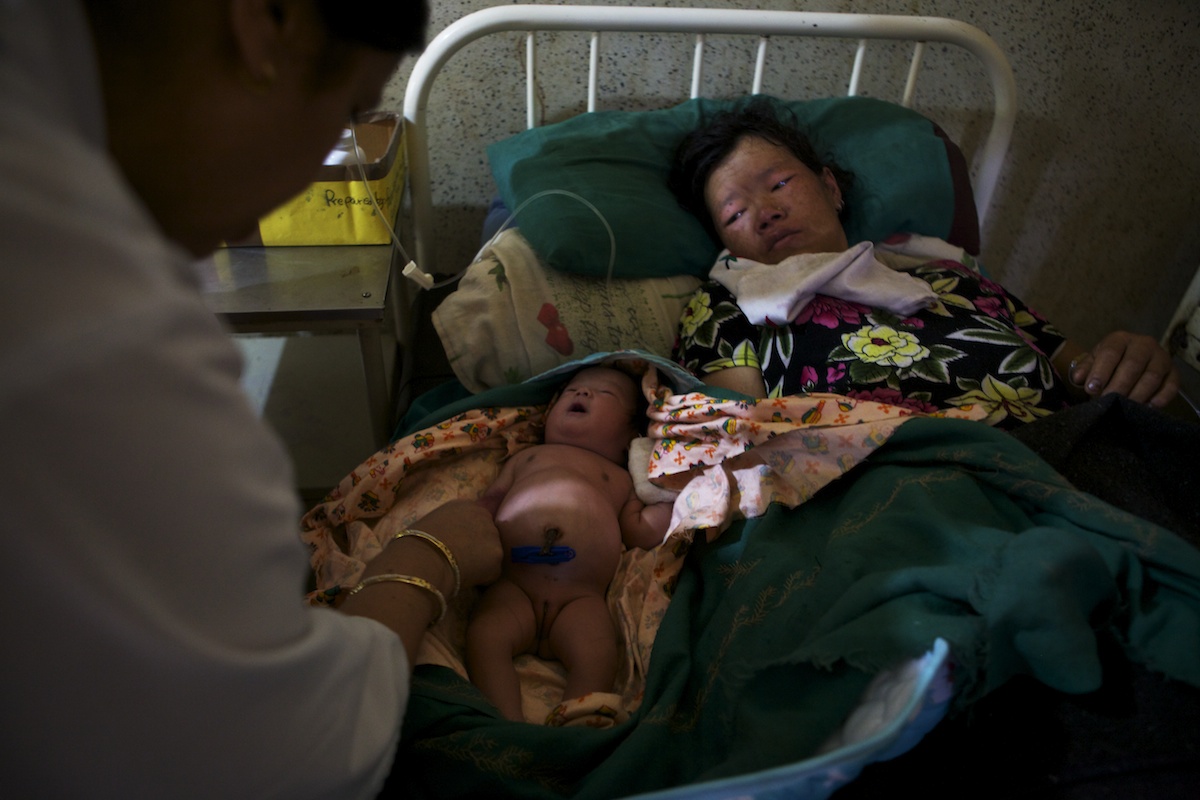
WELCOME LABOUR ROOM
She is quiet in a room of chaos and clatter. Tulkumaripun’s small frame sinks into the dark turquoise sheets of the Baglung District Hospital Maternity ward. The bright green of her traditional Nepalese dress blends into the sheets. As a new mother, her pained stillness seems out of place. A mob of young nursing students in lavender saris gather around her with worried expressions on their usually excited faces. Tulkumaripun barely opens her eyes, emitting only a soft moan as the drip’s position is modified. The lavender mob straightens her blankets, and then leaves her to rest.
Tulkumaripun had gone in to labour the day before, but there were complications. The baby’s arm had come out first leaving the unborn stuck in the birth canal, a potentially life threatening situation for both mother and child. Like most expecting Nepalese mothers in western Nepal, Tulkumaripun was at home, hours away from help.
The Journey
Baglung is nestled into the foothills of the Himalayas, three hours away from Pokhara, where mountaineers take off in search of the Annapurna range. The same mountains that inspire the breathtaking views and journeys, for which Nepal is famous, create unimaginable difficulties for expecting mothers like Tulkmaripun.
Tulkumaripun’s village Niskut is in Magdi, a district a couple hours away from the Baglung hospital. When the birth did not progress after hours of labour, her family carried her to the nearest road where they stopped a vehicle and bartered for her passage to the Magdi hospital. Upon arrival, the staff immediately recognised that she needed surgery and called for the ambulance jeep to take her and her family to the Baglung District Hospital - the only hospital in the Kali Gandaki valley with an operating theatre. She arrived in Baglung after an eight eight hour journey to the hospital, still in urgent need of medical attention.
Welcome Labour Room: The Maternity Ward at Baglung District Hospital
Tulkumaripun was given an immediate caesarean section when she arrived at the Baglung District Hospital, saving the mother’s life.
“She was very lucky”, says Janaki K.C., Baglung Hospital’s head nurse.
According to the World Health Organisation (WHO) about 800 women die per day from preventable complications during pregnancy and childbirth. 99% of these deaths occur in developing countries. The probability of a 15-year-old woman eventually dying from a maternal cause is “1 in 38000 in a developed country, versus 1 in every 150 in developing countries” states the WHO in their 2012 May report.
“Giving birth is like the fracture of 206 bones”, says nurse Janaki. She smiles grimly at the reality of this old Nepali saying. Janaki K.C. has been working as a nurse for the Baglung hospital for over twenty-five years and says obstructive labour like that of Tulkumaripun’s is just one of the common causes of maternal death. She explains the most common complications they treat at Baglung Hospital are after delivery hemorrhage, post abortion complications, and uterus prolapse.
Baglung District Hospital provides the major healthcare facilities for the entire Kali Gandaki valley. Head Physician, Doctor Tarun, first started working at the Baglung Hospital 13 years ago servicing 25 beds as the only doctor. The hospital now employs nine doctors and provides services to approximately 600,000 people in the district and surrounding areas.
Head nurse Janaki comments on the challenges in keeping up with this huge workload. She says that the shortage of “men, money and materials” is the main issue. Janaki estimates that of the 100-120 normal cases they treat per month, almost 10% of them are emergencies.
According to a recent study by the BMJ (British Medical Journal), Nepal continues to have the worse doctor to population ratio in Asia, citing a ratio of only two doctors per 10,000 people with only 27.2% (193 doctors), working outside of Kathmandu districts. BMJ explains, “Nepal is an Asian country with a population of 28 million; its mountainous topography and poverty (annual gross domestic product $300 (£193; €245) per capita)” continue to “create barriers to adequate healthcare.”
Nurse Janaki says that apart from the medical complications related to pregnancy and childbirth, the issue of transportation and geographic location often prevents women from accessing the medical treatment they urgently need.
With many women living in mountain villages high up on the valley walls, the women’s only connection to Baglung Hospital is by travelling on dirt roads and steep rocky paths, often alone. Landslides and monsoonal rains quickly cut off villages, making it unreasonable to make such a trip for simple medical advice that is so important to expecting mothers.
New Hope: Foot Soldiers of Change in the Foothills
On a small plateau overlooking the Kali Kandaki River, two hours hike from the bottom of the valley, Narayanstan is a small village that is home to an organization committed to doing its part. Mothers from this region must hike down a steep decent and cross the river at a cable bridge, before they can wave down a local bus to take them to Baglung Hospital.
“One woman and eight babies will die during childbirth,” states Arlene Samens, CEO and founder of international organisation One Heart World-Wide.
“I believe this is unacceptable,” she says.
One Heart World-Wide uses the power of education to empower women with valuable information that will ultimately save lives.
The organisation trains female community health workers from villages all over Baglung and Dolpa Districts. They conduct six-day training workshops teaching life saving techniques, such as, hygiene, basic nutrition, and how to spot the danger signs of pregnancy complications. The women then pass this life saving information on to the mothers and families back in their village.
In 2011, One Heart trained over 30 midwives, transitioned two remote health posts in Baglung district into birthing clinics, opened the first ever birthing clinic in Dolpa district, and trained over 60 doctors in their new “helping babies breath” program. These programs were able to reach 2000 mothers.
Tilkumari Kolpata, 58, has been volunteering for 15 years with One Heart World-Wide. Her eyes are bright and kind, and the corners of her mouth always seem to be edging into a smile.
When asked why she volunteers, she answers simply: “To serve the pregnant women, and the children and newborn babies.”
The women in her ward face many challenges.
“They all are poor, so they cannot afford to go to Baglung Hospital. They cannot pay for transportation, “ she explains.
She recalls one case of a breached delivery in her village last year where the family put off seeking medical assistance because of money. The baby died on the way to the hospital.
“These are difficult things,” says Tilkumari.
In a more recent case, she visited a young woman who, at four-months pregnant was working planting and picking millet. She had heavy bleeding so Tilkumari advised her to go for a check-up at the health post. At the post the health worker told her that if she did not stop lifting heavy loads the baby would die. “You will lose the baby,” he told her.
With a proud sigh, Tilkumari reports that the young lady took the advice and “is doing well now.”
Bina Kumari B.K., 31, has been volunteering in Narayansthan S. Namunagow for seven years.
“In my village lots of women die during pregnancy,” says Bina.
Bina experienced the fear many of her patients go through when she herself had serious complications fifteen days after the birth of her last child.
“It was lots of bleeding and it was all around the floor.” She explained that she had a huge clot in her vagina.
“I was nearly dying…I was unconscious, totally unconscious.” Her family took her to small village clinic in Paiyanpatta, “If I was not there in time, I would have died.”
Bina says the health worker from the clinic was also afraid and said: “I cannot do anything, take her to Baglung Hospital.”
He managed to do an IV infusion, giving Bina some energy, and possibly making the difference between her death and survival.
Bina now works as an advocate for the women within their families. She describes their hesitance to come to the health post for an antenatal check up.
“They won’t [have a check up] because they feel shy to expose in front of male. In their house their husband doesn’t let them go out, and mother-in-law says, ‘oh you don’t have to go for check ups.’ The women don’t have decision-making power. That is the problem.”
Bina speaks about her dedication to the women in her village. She says, “I want to serve them, and I don’t want to see the women and children dying.”
Maternal Mortality Worldwide
Maternal Mortality is deeply entwined with the continuation of poverty. In 2000, 189 countries committed to ending extreme poverty worldwide through the achievement of the eight Millennium Development Goals. (Giving Birth Should Not be a Matter of Life or Death, 3). The fifth Millennium Development Goal is to reduce Maternal Mortality by three quarters before 2015. These global goals are, “widely accepted as the path to ending poverty”.
However, less known is the fact that, “none of these goals can be achieved without more progress in promoting women’s reproductive rights and protecting maternal and newborn health” (Women Deliver, 2) as it is closely connected to all of the other development goals such as “reducing child mortality, stopping HIV and AIDS, providing education, and promoting gender equality” (Women Deliver, 3) to name a few.
Nepal was commended this year by the United States for its strong work towards completing the Millennium Development goals – Nepal has made substantial improvements to all but three of its health indicators. (Understanding Effects of Armed Conflict on Health Outcomes: The Case of Nepal). While statistics continue to be largely unreliable due to underreporting and small sample groups, it is clear that Nepal has strived to protect its citizens and improve their health outcomes over the past ten years, despite conflict and governmental flux.
Going Home
Back at the Baglung District Hospital, Tulkumaripun eyes are open. Her head is propped against a small pillow so she may watch over her newborn baby girl, as Janaki K.C. unwraps the newborn from her many colourful layers to check on the little hands. The hand that had come out of the birth canal first is bandaged in white gauze; the other hand’s tiny fingers are almost blue. Janaki explains the child has cyanosis—lack of oxygen—and will be sent to Pokhara with the mother’s sister, where the child can receive further treatment.
In preparation for transport, the child is placed in the nervous hands of the mother’s sister, who is escorted to the “ambulance” – a pick up truck with two benches fixed in the back and an oxygen tank stuck in the front cabin.
The truck scuttles down the dirt road towards the highway to Pokhara. The road is cracked and worn from years of landslides and the heavy rains of the monsoon season. Like the battered Baglung highway that is a lifeline for supplies and information to the Kali Kandaki valley, the hospital staff and One Heart World-wide trainers and volunteers are a lifeline to the many women of the remote mountain villages.
The staff and volunteers of the Baglung Hospital Maternity ward and One Heart World-Wide are dedicated to riding the Kali Gandaki Valley of the grim statistics associated with maternal health in the region—they are the guardian angles of this region, protecting one woman, one birth at a time.
Women Deliver 2009, ‘Focus on 5: Women’s Health and the MDGs,’ Women Deliver, New York, viewed 3 March 2011, <http://www.unfpa.org/public/home/publications/pid/3888>.
UNFPA 2001, ‘Giving Birth Should Not Be a Matter of Life and Death,’ UNFPA, United Nations Population Fund, New York, viewed 2 March 2011, <http://www.unfpa.org/webdav/site/global/shared/factsheets/maternal_health_fact_sheet%20-%20eng.pdf>.
Devkota, Bhimsen, and Edwin R. van Teijlingen. 2010. “Understanding Effects of Armed Conflict on Health Outcomes: The Case of Nepal.” Conflict and Health 4 (1) (December 1): 20. doi:10.1186/1752-1505-4-20.
Zimmerman, M., R. Shakya, B. M. Pokhrel, N. Eyal, B. P. Rijal, R. N. Shrestha, and A. Sayami. 2012. “Medical Students’ Characteristics as Predictors of Career Practice Location: Retrospective Cohort Study Tracking Graduates of Nepal’s First Medical College.” BMJ 345 (aug13 2) (August 14): e4826–e4826. doi:10.1136/bmj.e4826.

